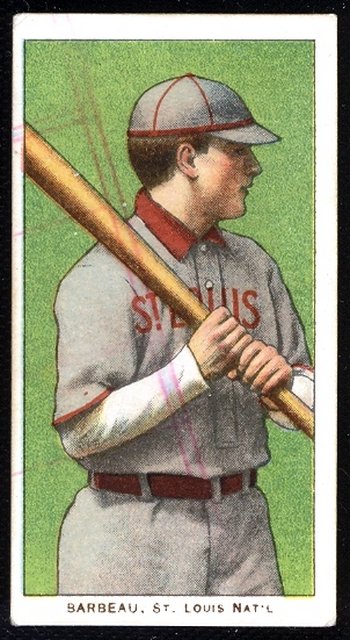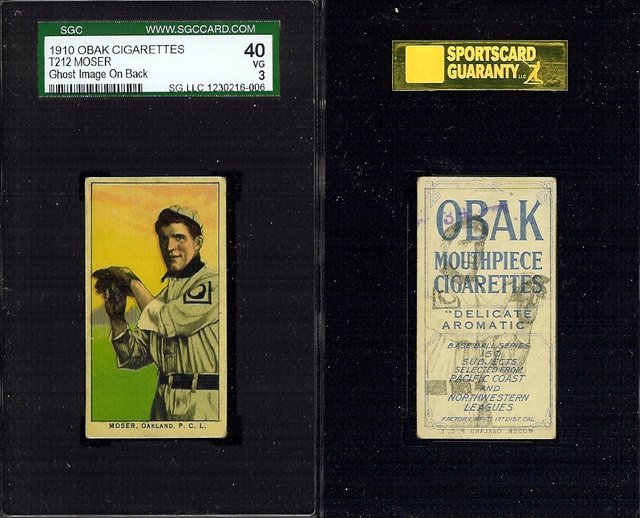|
|
|
|
#1
|
||||
|
||||
|
Quote:
I decided to clean the card because it was ruined anyway. I checked with a conservation expert and was told that a 90 year old oil stain would never fully release but that repeated baths in bestine [an artists' solvent used to remove oil-based materials like rubber cement or paint] would remove as much of the oil as could be removed. I bought a can of the stuff and put the card through repeated soaks in it until the fluid was clear, meaning no more oil to leach out of the card. I then dried the card. The soaks, or perhaps the effect of the oil over the decades, turned the white cardboard grayish. It was obvious and plain to see. The inks themselves on the card were not affected at all. I've encountered other cards from the T era with similar discolorations at shows and I know that they were dipped and stripped, so to speak. Anyone who has any experience with T cards could never mistake them for anything remotely close to factory released condition. I sold the card--with full disclosure--to a budget-conscious collector who was pleased to get a T202 Cobb at a fraction of the price of a nice one. Now, I have no doubt that a real nasty industrial solvent or bleach could remove colored printing from a card, but the damage would be profound and obvious, and would not lend itself to the sort of clean reversed images we see. What we are discussing is adding something to the card, not destroying original inks. Very different and much tougher to add something than to destroy something. I have examined thousands of white bordered T cards and many transfer-type cards--I've been actively searching for them for years--and I have never seen any transfer that appeared to be from other than an original printing. Perhaps transfers are one reason why modern printed materials like cards have a clear coat applied to the paper after the last of the inks--if you soak a modern card you will see that it curls, which is due to the coating not releasing like the uncoated card backs do. As for the prevalence, I see lots of Tolstoi, relatively speaking, with back transfers to the card fronts. Had to be something with the original ink used. I'm still trying to figure out WTF transferred to this card: 
__________________
Read my blog; it will make all your dreams come true. https://adamstevenwarshaw.substack.com/ Or not... Last edited by Exhibitman; 06-08-2012 at 01:10 PM. |
|
#2
|
|||
|
|||
|
Good post Adam. No idea what that is BTW neat card.
|
|
#3
|
||||
|
||||
|
As I said in my initial, itís my opinion that many of the transfers being discussed happened during the storage of the cards and not the printing process. This is based on looking at many examples of T206 transfers and the conclusions that I have drawn from doing so. Iím sure others will have a different opinion and I donít begrudge them that. Itís all good information to consider.
The card below is a great example of what I believe to be a transfer that happened during storage.  Given how the T206 cards were printed and packed for distribution to their factories, I canít come up with a plausible explanation for how a wet Sweet Caporal back would have transferred onto a Polar Bear card at the press. The Polar Bear and Sweet Caporal cards went to different factories and couldnít have been printed on the same press without the stone being changed. It makes little sense to intermingle the product after printing and then to resort it for distribution after cutting. Anything is possible, I just donít find it likely. Next if you overlay an image of a Sweet Caporal back onto the Overall you see where the top card only covers half of the right side border of the Overall. A close look at the unaltered Overall image shows a distinct line running down the middle of the right hand border. I believe that his was where the edge of the top card stopped leaving the remainder of the Overall border exposed. The edge between the two was a place for discoloration or grim to build up and produce the visible line.  I donít think that this transfer process can be reproduced by soaking a card for a number of hours or even weeks. I donít profess to know the recipe but I would guess humidity, pressure, and time would all play a role. Without the right mixture itís unlikely that we could reproduce the results. I think this process was extremely slow and the factor of time would limit most of us from being able to reproduce the results. Iím not saying wet sheet transfers donít exist. I just donít believe all transfers happened at the time of printing. Again itís just my opinion shared for the discussion. |
|
#4
|
||||
|
||||
|
I'd have to agree with Tim on a few of these. Here is one I have that looks more of an environmentally caused transfer.
Side note - I have seen a 649 SC back transferred on to a notebook sheet that was soaked off a card, likely due to the glue used.  Johnny I think you mean this one......very nice transfer. 
__________________
T206 gallery Last edited by atx840; 06-08-2012 at 02:45 PM. |
|
#5
|
||||
|
||||
|
Like I said, I'm sure that the right solvent could loosen the ink on anything. But look at how hazy the ink is on the cards shown as examples of 'storage transfers' and how damaged the 2nd card looks to boot--like a stain you'd be hard-pressed to identify if you didn't know it was a SC back image--readily distinguished from the crisp ghosts we are used to seeing.

__________________
Read my blog; it will make all your dreams come true. https://adamstevenwarshaw.substack.com/ Or not... Last edited by Exhibitman; 06-08-2012 at 03:03 PM. |
|
#6
|
|||
|
|||
|
Adam, agree.
Something beyond the natural environment, time etc. was involved to create such cards like the Polar Bear card Tim posted. Not saying it was done on purpose or anything just something got to those cards beyond natural storage circumstances IMO. As I said prior been thru thousands of these and other tobacco issues from the era found every way under the sun, but have yet to ever see or peel away another card to see the traces of the card on top. Then there’s the fundamental question I asked earlier…..where are all the ghost fronts of ball players, flags, fish etc. on the backs of these cards? Seems to me this natural occurring set of conditions would also render copies of fronts on backs not just backs on fronts…. Cheers, John P.S. Adam you have to sell me that card one day. 
Last edited by wonkaticket; 06-08-2012 at 03:14 PM. |
|
#7
|
||||
|
||||
|
Quote:

__________________
Leon Luckey www.luckeycards.com |
|
#8
|
||||
|
||||
|
Quote:
|
 |
|
|
 Similar Threads
Similar Threads
|
||||
| Thread | Thread Starter | Forum | Replies | Last Post |
| . | npa589 | Tobacco (T) cards, except T206 B/S/T | 8 | 05-10-2012 03:48 PM |
| T206 / T205s - all HOFs / graded (lower grades) | Section103 | Tobacco (T) cards, except T206 B/S/T | 4 | 10-15-2010 12:42 PM |
| Listed on Ebay JACK JOHNSON T227 and MATHEWSON T206 | Archive | Ebay, Auction and other Venues Announcement- B/S/T | 0 | 10-01-2007 11:05 PM |
| On Ebay: T206 Blackburne Old Mill, T206 Schulte back view, T206 Doolin/Doolan, T207 Street | Archive | Ebay, Auction and other Venues Announcement- B/S/T | 0 | 03-04-2007 10:07 AM |
| Current T206 market and pondering Wagner value | Archive | Net54baseball Vintage (WWII & Older) Baseball Cards & New Member Introductions | 26 | 01-21-2007 04:26 PM |